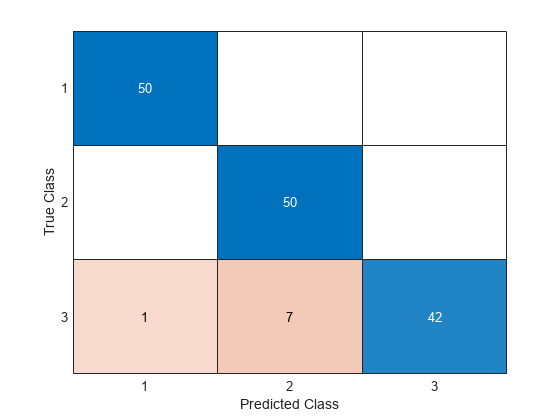predict
Label new data using semi-supervised self-trained classifier
Description
Examples
Use both labeled and unlabeled data to train a SemiSupervisedSelfTrainingModel object. Label new data using the trained model.
Randomly generate 15 observations of labeled data, with 5 observations in each of three classes.
rng('default') % For reproducibility labeledX = [randn(5,2)*0.25 + ones(5,2); randn(5,2)*0.25 - ones(5,2); randn(5,2)*0.5]; Y = [ones(5,1); ones(5,1)*2; ones(5,1)*3];
Randomly generate 300 additional observations of unlabeled data, with 100 observations per class.
unlabeledX = [randn(100,2)*0.25 + ones(100,2);
randn(100,2)*0.25 - ones(100,2);
randn(100,2)*0.5];Fit labels to the unlabeled data by using a semi-supervised self-training method. The function fitsemiself returns a SemiSupervisedSelfTrainingModel object whose FittedLabels property contains the fitted labels for the unlabeled data and whose LabelScores property contains the associated label scores.
Mdl = fitsemiself(labeledX,Y,unlabeledX)
Mdl =
SemiSupervisedSelfTrainingModel with properties:
FittedLabels: [300×1 double]
LabelScores: [300×3 double]
ClassNames: [1 2 3]
ResponseName: 'Y'
CategoricalPredictors: []
Learner: [1×1 classreg.learning.classif.CompactClassificationECOC]
Properties, Methods
Randomly generate 150 observations of new data, with 50 observations per class. For the purposes of validation, keep track of the true labels for the new data.
newX = [randn(50,2)*0.25 + ones(50,2);
randn(50,2)*0.25 - ones(50,2);
randn(50,2)*0.5];
trueLabels = [ones(50,1); ones(50,1)*2; ones(50,1)*3];Predict the labels for the new data by using the predict function of the SemiSupervisedSelfTrainingModel object. Compare the true labels to the predicted labels by using a confusion matrix.
predictedLabels = predict(Mdl,newX); confusionchart(trueLabels,predictedLabels)

Only 8 of the 150 observations in newX are mislabeled.
Input Arguments
Semi-supervised self-training classifier, specified as a SemiSupervisedSelfTrainingModel object returned by
fitsemiself.
Predictor data to be classified, specified as a numeric matrix or table. Each row of
X corresponds to one observation, and each column corresponds to
one variable.
If you trained Mdl using matrix data (X and
UnlabeledX in the call to fitsemiself), then
specify X as a numeric matrix.
The variables in the columns of
Xmust have the same order as the predictor variables that trainedMdl.The software treats the predictors in
Xwhose indices matchMdl.CategoricalPredictorsas categorical predictors.
If you trained Mdl using tabular data (Tbl
and UnlabeledTbl in the call to fitsemiself),
then specify X as a table.
All predictor variables in
Xmust have the same variable names and data types as those that trainedMdl(stored inMdl.PredictorNames). However, the column order ofXdoes not need to correspond to the column order ofTbl. Also,TblandXcan contain additional variables (for example, response variables), butpredictignores them.predictdoes not support multicolumn variables or cell arrays other than cell arrays of character vectors.
Data Types: single | double | table
Output Arguments
Predicted class labels, returned as a categorical or character array, logical or
numeric vector, or cell array of character vectors. label has the
same data type as the fitted class labels Mdl.FittedLabels, and its
length is equal to the number of rows in X.
Predicted class scores, returned as a numeric matrix. score has
size m-by-K, where m is the
number of observations (or rows) in X and K is
the number of classes in Mdl.ClassNames.
score(m,k) is the likelihood that observation
m in X belongs to class k,
where a higher score value indicates a higher likelihood. The range of score values
depends on the underlying classifier Mdl.Learner.
Version History
Introduced in R2020b
See Also
MATLAB Command
You clicked a link that corresponds to this MATLAB command:
Run the command by entering it in the MATLAB Command Window. Web browsers do not support MATLAB commands.
Select a Web Site
Choose a web site to get translated content where available and see local events and offers. Based on your location, we recommend that you select: .
You can also select a web site from the following list
How to Get Best Site Performance
Select the China site (in Chinese or English) for best site performance. Other MathWorks country sites are not optimized for visits from your location.
Americas
- América Latina (Español)
- Canada (English)
- United States (English)
Europe
- Belgium (English)
- Denmark (English)
- Deutschland (Deutsch)
- España (Español)
- Finland (English)
- France (Français)
- Ireland (English)
- Italia (Italiano)
- Luxembourg (English)
- Netherlands (English)
- Norway (English)
- Österreich (Deutsch)
- Portugal (English)
- Sweden (English)
- Switzerland
- United Kingdom (English)